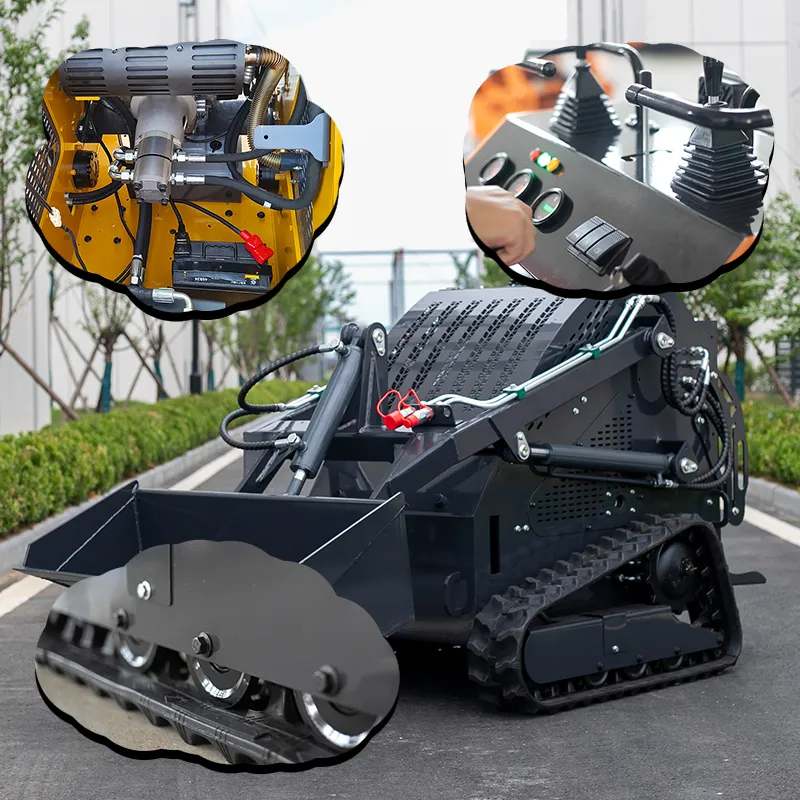Get Quote Now!
Welcome to discuss your purchasing requirements with our customer service.
A skid steer loader is a compact, engine-powered machine featuring lift arms capable of attaching to various tools or attachments. Its unique steering mechanism allows the wheels on each side to operate independently, enabling the machine to turn by skidding, which is particularly useful in confined spaces. Skid steer loaders are renowned for their versatility, maneuverability, and ability to perform a multitude of tasks across construction, landscaping, agriculture, and other industries. Their compact size and adaptability make them indispensable equipment on job sites requiring efficient material handling and earthmoving capabilities.

Skid steer loaders are characterized by their compact design, agility, and versatility. Their ability to turn within their own footprint makes them ideal for operations in tight or confined spaces where larger equipment cannot maneuver effectively. The machines are equipped with a robust hydraulic system that powers various attachments, allowing them to perform tasks such as digging, grading, lifting, and material handling.
These loaders are suitable for a wide range of scenarios, including construction sites, agricultural fields, landscaping projects, snow removal, and demolition work. Their adaptability is further enhanced by the availability of numerous attachments like buckets, augers, trenchers, and pallet forks, which can be quickly interchanged to suit different tasks.
The value of skid steer loaders lies in their multifunctionality and efficiency. By consolidating the capabilities of multiple machines into one compact unit, they reduce the need for additional equipment, thereby saving on costs and space. Their ease of operation and maintenance also contribute to lower operational costs, making them a cost-effective solution for various industries. Moreover, their durability and reliability ensure long-term performance, providing a high return on investment for businesses.

The power system of a skid steer loader comprises the engine, cooling system, and fuel system. Typically, these machines are powered by diesel engines ranging from 49 to 74 horsepower, providing the necessary force for demanding tasks . The cooling system, which includes a radiator and cooling fan, ensures the engine operates within optimal temperature ranges, preventing overheating during prolonged use . The fuel system, often featuring direct injection technology, delivers fuel efficiently to the engine, enhancing performance and fuel economy .
Skid steer loaders utilize a hydrostatic transmission system, which employs hydraulic pumps and motors to transfer power from the engine to the wheels, allowing for smooth and responsive control . The drive axle connects the hydraulic motors to the wheels, facilitating movement and maneuverability. For braking, these machines often incorporate disc brake systems mounted on the motor shaft, providing reliable stopping power and parking capabilities . This combination ensures efficient power delivery and control during operation.
Skid steer loaders are available with either tire or track configurations. Tire-equipped models offer excellent maneuverability on hard surfaces and are suitable for general-purpose tasks. Track-equipped models provide superior traction and stability on soft, uneven, or muddy terrains, making them ideal for challenging environments .
The working device of a skid steer loader includes the lift arm structure, attachment quick-change system, and standard bucket. The lift arms, typically in a radial or vertical lift design, provide the lifting capability. The quick-change system allows for rapid swapping of attachments, enhancing versatility .
The hydraulic system is central to a skid steer loader’s functionality, comprising the main hydraulic pump, control valve group, and hydraulic cylinders. The main pump generates the hydraulic pressure required to operate attachments and the lift arms. The control valve group regulates the flow and direction of hydraulic fluid, enabling precise control of movements . Hydraulic cylinders convert the hydraulic pressure into linear motion, facilitating the lifting and tilting actions of the loader’s arms and attachments. This system ensures smooth and efficient operation across various tasks .
Skid steer loaders feature either open or enclosed cabs. Enclosed cabs provide protection from environmental elements and enhance operator comfort, while open cabs offer easier access and visibility. Control systems typically include hand-operated joysticks and foot pedals, allowing for intuitive operation . The instrument panel displays critical information such as engine status, hydraulic pressure, and fuel levels, enabling operators to monitor the machine’s performance effectively. Additionally, safety interlock systems may be present, disabling the hydraulic functions when the operator is not seated or the armrests are raised, ensuring safe operation .
The frame structure of a skid steer loader consists of the main frame, rear counterweights, and outer cladding. The main frame provides structural integrity and houses key components. Rear counterweights enhance stability during lifting operations . Outer cladding protects internal components from environmental damage and contributes to the machine’s durability .
Safety and auxiliary systems in skid steer loaders include lighting systems, emergency stop buttons, and audible and visual alarms. Lighting systems ensure visibility during low-light conditions, enhancing operational safety. Emergency stop buttons allow for immediate shutdown in case of emergencies. Audible alarms, such as backup alarms, alert nearby personnel when the machine is in reverse, while visual alarms, like beacon lights, signal the machine’s operational status . These features collectively contribute to a safer working environment, reducing the risk of accidents and improving overall operational efficiency.
Welcome to discuss your purchasing requirements with our customer service.